 Image search results - "spa" Image search results - "spa" |
|
|
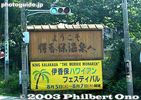
Ikaho is also a sister city of Hawaii island. During Aug. 5-7, 2003, Ikaho hosted the 7th King Kalakaua Merrie Monarch Hawaiian Festival featuring hula performances by numerous Japanese hula groups.
|
|
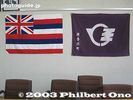
In the evenings, Hawaii's top hula halau (winner of the Merrie Monarch Festival in Hawaii) performed as the festival's main event. Photo: Flags of Hawaii and Ikaho town (merged with Shibukawa in 2006).
|
|
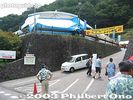
Town parking lot with a makeshift stage and main venue of the festival. The "Merrie Monarch" refers to King David Kalakaua who reigned over the Hawaiian Kingdom 1874-1891. He promoted hula in Hawaii as well as Japanese immigration to Hawaii.
|
|
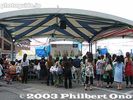
Canopy for the spectators fronting the main outdoor stage.
|
|
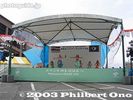
Main stage where many Japanese hula troupes performed during the day for three days. Free admission.
|
|
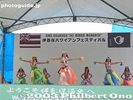
Tahitian dances were also performed.
|
|
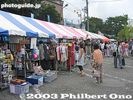
Hawaiian souvenirs for sale.
|
|
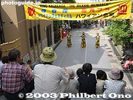
Ikaho is famous for the Stone Steps lined with shops. A section of it also served as a second hula stage during the day.
|
|

Hula on the Stone Steps 石段街
|
|
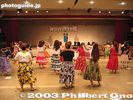
Hula workshops are also offered during the day at cost. A famous kumu hula teacher from Hawaii teaches the class.
|
|
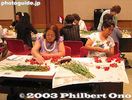
Other workshops are held such as ukulele lessons and a lei-making class.
|
|
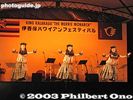
In the evenings, the overall winner of the annual Merrie Monarch Festival in Hawaii performed on stage. In 2003, it was Hula Halau 'O Kamuela from Oahu. They performed both the ancient hula kahiko dances (pictured here) and modern auana dances in Ikah
|
|
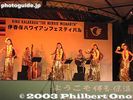
The Ikaho hula festival is officially sanctioned by The Merrie Monarch Festival, held in spring in Hilo, Hawaii. It is the most important and prestigious hula competition.
|
|
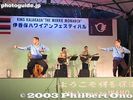
Hula is also performed by men. These photos were taken during the 7th Ikaho Hawaiian Festival (Aug. 5-7, 2003).
|
|
|
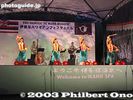
They wore a variety of colorful costumes and used various hula instruments such as these frayed bamboo sticks called Pūʻili.
|
|
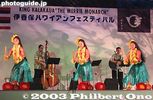
Modern hula dances such as this one is mainly for tourist entertainment.
|
|
|
|
|
|

After the bamboo sticks, the girls used a gourd drum called ipu.
|
|
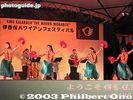
Finally, they use feathered gourd rattles called Ulīʻulī.
|
|
|
|
|

They are professional hula dancers, some of the best in the world.
|
|

The kumu hula is Kamana'o Anson Kauionalani or Kaui for short. He does a solo dance here. The music was performed by a wonderful Hawaiian trio called 'Ale'a.
|
|
|
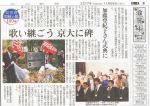
Chunichi Shimbun article (Nov. 26, 2017) about Kyoto University's celebration of the 100th anniversary of Biwako Shuko no Uta including the unveiling of the new song monument on campus.
|
|
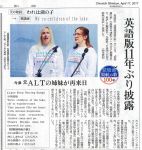
Chunichi Shimbun article (April 17, 2017) about our Lake Biwa Rowing Song mini concert held in Imazu on April 16, 2017. See videos of this event here: https://youtu.be/9G94IppUiiE
https://youtu.be/PjnY67sIcqE
|
|
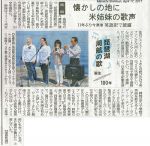
Mainichi Shimbun article (April 17, 2017) about our Lake Biwa Rowing Song mini concert held in Imazu on April 16, 2017.
|
|
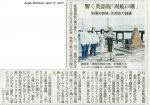
Asahi Shimbun article (April 17, 2017) about our Lake Biwa Rowing Song mini concert held in Imazu on April 16, 2017.
|
|

Sankei Shimbun article (April 17, 2017) about our Lake Biwa Rowing Song mini concert held in Imazu on April 16, 2017.
|
|

Yomiuri Shimbun article (April 17, 2017) about our Lake Biwa Rowing Song mini concert held in Imazu on April 16, 2017.
|
|
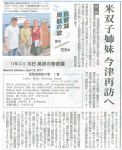
Mainichi Shimbun article (April 12, 2017) announcing our upcoming Lake Biwa Rowing Song mini concert to be held in Imazu on April 16, 2017.
|
|
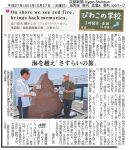
Kyoto Shimbun article mentioning the song's roots in the UK, May 27, 2015
|
|

"Lake Biwa Rowing Song CD on sale," June 17, 2007, Asahi Shimbun, Shiga Edition.
|
|

"Lake Biwa Rowing Song sung during Lake Biwa Cruise," June 17, 2007, Kyoto Shimbun, Shiga Edition.
|
|

"Lake Biwa Rowing Song photo exhibition at Imazu," June 5, 2007, Chunichi Shimbun, Biwako Edition
|
|

"Biwako Shuko no Uta in English, Beloved Song Translated" at Yokaichi Public Library, May 15, 2007, Shiga Hochi Shimbun 滋賀報知新聞
|
|

"Lake Biwa Rowing Song photo exhibition at Yokaichi Public Library," (Letter to the Editor), May 26, 2007, Kyoto Shimbun.Written by Masahiro Beniya.
|
|

"Japanese speech contest by foreigners in Shiga," Feb. 26, 2007, Chunichi Shimbun, Chunichi-Shiga pageWon by Jamie Thompson for her speech about Lake Biwa Rowing Song.
|
|

"13 contestants in Japanese speech contest by foreigners in Shiga," Feb. 26, 2007, Kyoto Shimbun, Shiga News
|
|
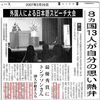
"Japanese speech contest by foreigners in Shiga, Ms. Thompson wins," Feb. 26, 2007, Mainichi Shimbun, Shiga Edition
|
|

"Lake Biwa Rowing Song photo exhibition in Takashima," June 12, 2006, Chunichi Shimbun, Chunichi-Shiga page. (The man in the picture is not Philbert.)
|
|
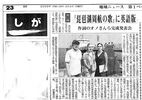
"Lake Biwa Rowing Song completed in English and performed in public," June 4, 2006, Mainichi Shimbun, Shiga News
|
|
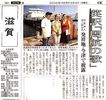
"Lake Biwa Rowing Song performed in public in Imazu, the song's birthplace," June 4, 2006, Yomiuri Shimbun, Shiga News
|
|
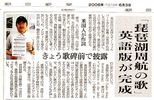
"Lake Biwa Rowing Song completed in English by an American," June 3, 2006, Asahi Shimbun, Shiga News
|
|
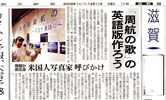
"Let's make an English version of Biwako Shuko no Uta," Dec. 11, 2005, Asahi Shimbun, Shiga News
|
|

JR Atami Station
|
|

Gift shops next to Atami Station. The architecture doesn't match the station at all.
|
|
|

In front of Atami Station.
|
|

Hot spring foot bath next to Atami Station.
|
|
|

Tokugawa Ieyasu's hot spring.
|
|

In front of Atami Station.
|
|

Onsen manju, sweet bean jam cakes steamed with hot spring water are sold everywhere in Atami.
|
|

Onsen manju
|
|
|

Entrance to shopping arcade.
|
|

Inside Heiwa-dori shopping arcade.
|
|

Hot spring fountain as a hand bath.
|
|

Lots of sloping roads in hilly Atami.
|
|

Directions
|
|
|
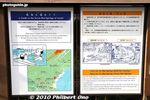
About Atami's seven hot springs
|
|

Atami Ginza is quite deserted during the day.
|
|

Atami Ginza is a street of shops.
|
|

Hawaiian restaurant in Atami Ginza.
|
|

Some cherry trees near the beach.
|
|
|

Rainbow Deck
|
|
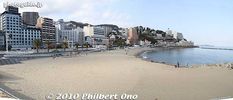
Atami Sun Beach is popular in summer.
|
|

It takes about 20 min. to walk to the beach from Atami Station.
|
|

Imagine hpw crowded the beach will get when they have summer fireworks in Atami.
|
|
|
|

Atami Moon Terrace
|
|

The beachfront is a mishmash of buildings.
|
|
|

Water fountain for lovers.
|
|

Ferry
|
|

Hatsushima island
|
|

Ferries go to Hatsushima and Oshima islands.
|
|

Yacht harbor
|
|

Peninsula on the right side is unsightly with another mishmash of structures.
|
|

Fake castle in Atami, but a landmark nevertheless.
|
|

Plaque for Sir Rutherford Alcock, the first British ambassador to Japan and the first foreigner to climb Mt. Fuji. He stopped in Atami on the way back from Mt. Fuji.
|
|

Tacky bridges leading to the sleazy side of town.
|
|
|

Atami has a few hot spring public baths where you can enjoy the waters without having to stay at a hotel. It costs around 500 yen to 1000 yen.
|
|
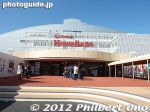
Main entrance to Spa Resort Hawaiians, a huge water park and onsen hot spring amusement facility built in 1966. I visited for the first time shortly after they reopened on Feb. 8, 2012.
|
|
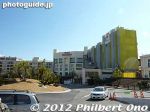
One wing of Hotel Hawaiians was still undergoing repairs to cracks.
|
|
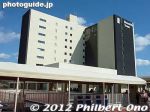
The new Monolith Hotel opened on Feb. 8, 2012.
|
|

After completing earthquake repairs, the water park re-opened on Feb. 8, 2012. Admission was half price.
|
|

Layout of Spa Resort Hawaiians.
|
|
|
|
|
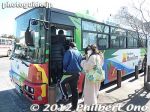
From JR Yumoto Station, free shuttle buses run to Spa Resort Hawaiians.
|
|

The huge water park at Spa Resort Hawaiians. All the water is from a hot spring. The pool water is lukewarm.
|
|
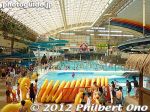
The whole water park is heated to tropical temperatures even when it is freezing outside.
|
|
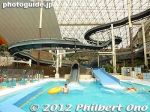
The water slides cost extra money. 200 yen per slide.
|
|
|
|
|
|
|
|
|
|
|
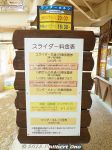
The water slides cost extra money. 200 yen per slide or a day pass for 2,200 yen.
|
|
|
|

Wading pool.
|
|
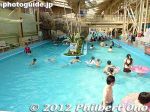
Wading pool.
|
|
|

Besides the pools, there are real hot spring baths where you have to go in naked. Cameras not allowed though.
|
|

Spring Park, a lukewarm hot spring pool.
|
|

Spa Garden Pareo has outdoor pools and a sauna. In winter, the air is freezing cold.
|
|
|
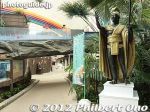
Statue of King Kamehameha even!
|
|

Hula lesson for kids at the Beach Theater in the Water Park.
|
|
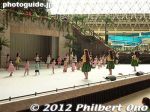
Hula lesson for kids at the Beach Theater in the Water Park.
|
|
|
|
|
|
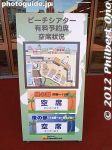
Beach Theater shows are free, but they also sell tickets for the best seats for ¥600 to ¥800.
|
|

Colored seats are reserved and cost extra.
|
|
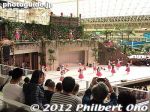
Hula Girl Polynesian Revue at 1:30 pm to 2:15 pm at the Beach Theater.
|
|
|
|
|
|
|
|
|
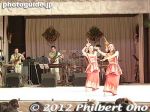
The live band were all Japanese. All the dancers were Japanese and most are from Fukushima.
|
|
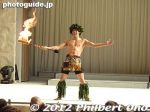
Fire knife dancers are the highlight and crowd pleasers. They are Japanese, but well-trained and highly skilled with the fire.
|
|
|
|
|
|
|
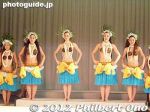
Great dancers and great show!
|
|
|
|
|
|
|
|
|
|
|
|
|
|
|
|
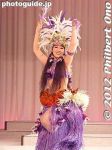
This is Maluhia Yukari, the leader of the hula girls. She was a pivotal in taking the lead following the 3/11 disasters and promoting Spa Resort Hawaiians on tour. She retired in June 2012. マルヒア由佳理
|
|
|
|
|
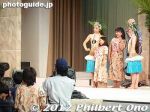
At the end of the show, people who paid for reserved seats could have their picture taken with the hula girls.
|
|
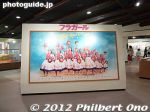
The Hula Museum shows the history of Spa Resort Hawaiians first established as Joban Hawaiian Center in 1966.
|
|
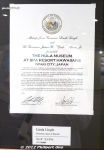
Congratulatory letter from the Governor of Hawaii, Linda Lingle, upon the opening of the Hula Museum.
|
|
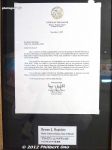
Congratulatory letter from the mayor of Kauai upon the opening of the Hula Museum.
|
|

How Spa Resort Hawaiians got its start.
|
|

Recruitment of hula girls.
|
|
|
|
|
|
|
|
|
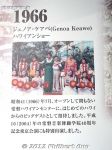
Shortly after Joban Hawaiian Center opened in 1966, famous singer Aunty Genoa Keawe from Hawaii performed here.
|
|
|
|
|
|
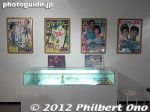
Hawaiian movie posters.
|
|
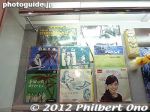
Hawaiian records by Japanese artists.
|
|
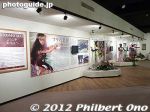
The second room of the Hula Museum introduces hula.
|
|
|
|
|
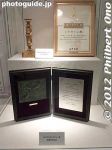
The 2006 comedy movie, "Hula Girl" was a major hit and made Spa Resort Hawaiians famous again. Awards given to the movie.
|
|
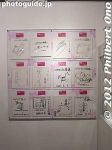
Autographs by the actors and actresses in the movie, "Hula Girl."
|
|

Autographs by the actors and actresses in the movie, "Hula Girl."
|
|
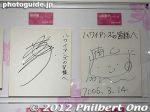
Autographs by the actors and actresses in the movie, "Hula Girl."
|
|
|
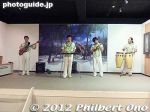
The Hula Museum also has a small stage where this band performed at 12:30 pm.
|
|
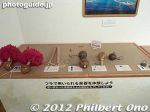
Hula implements.
|
|

My video of Spa Resort Hawaiians. Visit Fukushima, visit Spa Resort Hawaiians!
|
|
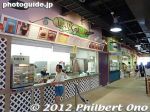
Eateries. This one is named Lau Lau, but no lau lau is served.
|
|
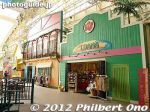
Hawaiian gift shops.
|
|

Inside Hawaiian gift shop.
|
|
|
|
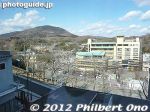
View from Spa Resort Hawaiians.
|
|
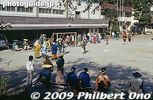
The following pictures were taken in an earlier year (not 2009). Hakone Daimyo Gyoretsu Procession starts at Yumoto Elementary School at 10 am. 湯本小学校
|
|
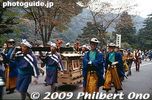
The procession reenacts the daimyo procession of Okubo Kaga, lord of Odawara on his way to Edo (Tokyo) for the periodic sankin kotai procession.
|
|

Ladies in waiting. These pictures were taken some time ago (not in 2009). Since I saw it, the procession has gotten larger with more groups.
|
|
|
|
|
|
|
|
|
|
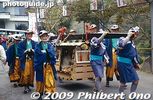
The daimyo lord is carried in a palanquin for the Hakone Daimyo Gyoretsu Procession. 大名駕籠
|
|
|
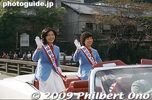
Hakone Tourism Companions
|
|
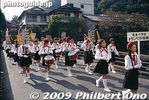
Yumoto Elementary School
|
|
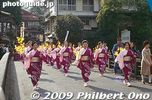
Before the feudal lord procession, there are normal people in dance groups, etc.
|
|
|
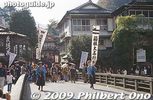
The start of the Daimyo Procession. You hear, "Shitaaaa-niii, shitaaaa-niiii" (Go down, go down!) by the tsuyu-harai dew sweepers who lead the way to tell people to clear the way and bow in respect. 下ニー 下ニー
|
|

These men are the luggage carriers carrying the hasami-bako boxes containing clothing and other necessities. Hakone Daimyo Gyoretsu. 挟み箱
|
|

The Hakone Daimyo Gyoretsu Procession started in 1935 on the occasion of the Yumoto Expo. Except for the war years in the 1940s, this festival has been held annually.
|
|
|
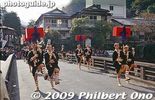
Luggage carriers carrying the hasami-bako boxes containing clothing and other necessities. 挟み箱
|
|
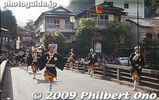
These men are the keyari who carry fluffy-topped poles and toss the poles to each other. 毛槍
|
|

These men are the keyari who carry fluffy-topped poles and toss the poles to each other. 毛槍
|
|
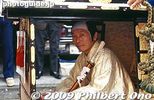
The daimyo feudal lord in Hakone Daimyo Gyoretsu Procession.
|
|
|

Ladies in waiting. 奥女中
|
|
|
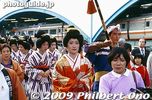
She was definitely the focal point of the procession before they started using a celebrity to play the daimyo. They past Yumoto Station in the background in the Hakone Daimyo Gyoretsu Procession.
|
|
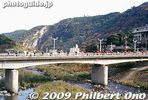
Crossing Yumoto Ohashi Bridge
|
|
|
|
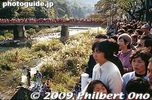
A large crowd watch the procession cross the Yumoto Ohashi Bridge. The parade ended at 2:30-3 pm.
|
|

Hakone Daimyo Gyoretsu Procession poster. To get to Hakone Yumoto, take the Odakyu Line Romance Car from Shinjuku. A cheaper but longer way is to take the Odakyu Line to Odawara, then take the Hakone Tozan Railway train to Hakone Yumoto Station.
|
|

Main venue of the Ikaho Merrie Monarch Hawaiian Festival held every summer in Ikaho Spa, Gunma Prefecture since 1997. It is on a city-operated parking lot. 伊香保ハワイアンフェスティバル会場
|
|

The main venue has two large adjoining tents. The tent on the left covers the stage, and the one on the right covers the audience seats. The place is ringed by outdoor shops selling Hawaiian goods (mainly clothing).
|
|

About 600 seats at the main venue. Ikaho's connection to Hawaii lies with the summer residence of Robert Walker Irwin, the Hawaiian Minister to Japan during the late 19th century.
|
|

The Hawaiian festival's opening ceremony was held on the festival's first day on Aug. 3, 2008. Among Japan's many hula festivals, this one is unique since it is organized by a city government based on sister-city ties.
|
|

The opening ceremony included a few speeches and a ukulele performance by Mr. San'uemon Chigira, the chairman of the festival committee.
|
|

Short greetings by Luana Saiki-Kawelu, Assistant Director of the Merrie Monarch Festival in Hilo, Hawaii. Ikaho's Hawaiian festival is Japan's only hula event officially endorsed by the Merrie Monarch Festival in Hilo.
|
|

A few words by Kau'i Kamana'o, kumu hula of Hula Halau 'O Kamuela who was the festival's guest performer and overall winner of the 2008 Merrie Monarch Festival in Hilo, Hawaii.
|
|

Kumu hula Kunewa Mook also speaks at the opening ceremony. In the background is the flag of the city of Shibukawa. In Japan, all cities, towns, and villages have their own official logo and flag.
|
|

Kumu hula Aloha Dalire, instructor of the Hawaiian seminars during the festival, also greets the audience. アロハ・ダリレ
|
|

Thomas Goya, from Hilo and president of the Japanese Community Association of Hawaii, speaks as a representative of the County of Hawai'i, Ikaho's sister city. ハワイ島日系人協会会長
|
|
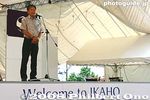
Tommy Hirano, Honorary Consul-General of Japan from Hilo, Hawaii also speaks. It was his first visit to Ikaho.
|
|

Signboard at the entrance to Ikaho Spa. ("Monach" is spelled wrong.) "Monach"はスペルミス。
|
|

Main venue of the Ikaho Hawaiian Festival. メイン会場
|
|

Shops around the main venue.
|
|

More shops on the lower level.
|
|
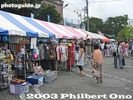
Shops on the lower level.
|
|

During Aug. 3-6, 2008, about 390 hula groups (totaling 4,700 people) performed on this stage. About 838 hula groups applied to perform, and only 390 could be selected to appear.
|
|
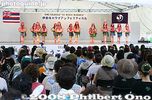
Every 4 minutes, a new group of hula dancers went on and performed on stage. This went on for four days 10 am to 6 pm (except on the first day when it started from 1 pm).
|
|

The first day featured Keiki Hula (hula by children).
|
|

Once upon a time, hula in Japan was mainly done by elderly women. Not anymore as hula's popularity has spread to all ages in Japan.
|
|

All the seats were filled during the all-day performances. So many hula groups applied to perform during the festival that Ikaho had to draw lots to decide who could appear.
|
|

For many women, hula is good exercise, recreational fun, or a chance to look and feel like a different person. The colorful costumes, flowers, attractive movements, and glamorous setting are all very appealing.
|
|

Kupuna 4分ごとに各フラチームがステージで出演。
|
|

The famous Stone Steps of Ikaho. Ikaho is on a mountain slope, and the Stone Steps goes through the center of the hot spring town. It is lined with shops and inns. ("Monach" is spelled wrong.) "Monach"はスペルミス
|
|

One section of the Stone Steps also served as another venue for Ikaho's Hawaiian Festival. 「街角フラ」石段にて
|
|

This venue is called "Machikado Hula." (Street corner hula). It went on from 11 am to 5 pm during the four-day festival (except on the first day when it started from 1 pm).
|
|

The audience sit on the Stone Steps to watch the "Street corner hula." So what did they do when it rained?
|
|

A few hula dancers take a break after performing their number on the Stone Steps.
|
|

A total of five 90-min. Hawaiian seminars were held during Ikaho's Hawaiian festival in Aug. 2008, and they were all taught by kumu hula Aloha Dalire who was very well received by the (thrilled) students.
|
|

Kumu hula Aloha Dalire explains that she is a 7th-generation kumu hula in her family, and produced five Miss Aloha Hulas at the Merrie Monarch Festival in Hilo, including all three of her daughters and Kuhi Suganuma, the 2008 Miss Aloha Hula.
|
|

Aloha Dalire taught seminars in hula history, Hawaiian expression, and lei-making (pictured here). She brought a boxful of a'ali'i flowers for lei-making. All the students had heard of the flower, but it was the first time for them to see it.
|
|

Aloha also taught two hula workshops. For the first workshop, she taught the song "Nani Lawa'i" (sung by Na Palapalai). First, she had the students close their eyes and listen to the song.
|
|

Aloha Dalire teaching hula in Ikaho. The Hawaiian workshops were held at the Ikaho Kaikan Hall in central Ikaho. アロハ・ダリレが教えるフラセミナー
|
|
| 1193 files on 5 page(s) |
1 |
 |
 |
|